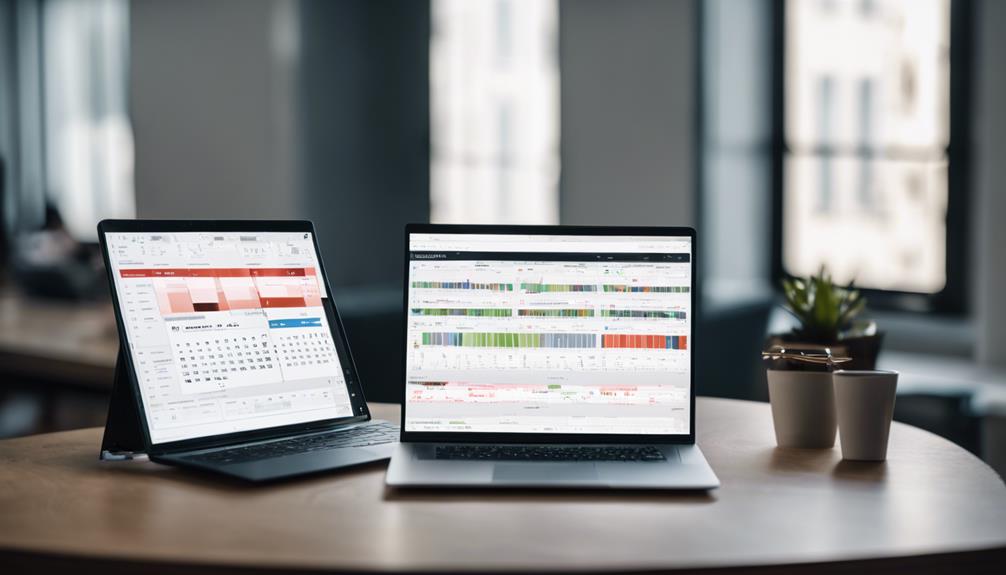Effective Email Marketing Campaign Strategies
You're likely no stranger to the importance of email marketing in driving business growth. But with so many campaigns flooding inboxes daily, what sets the successful ones apart? It all starts with a solid foundation: a well-crafted email list. You've probably spent time and resources building yours, but are you getting the most out of it? The key to releasing your email list's full potential lies in understanding what makes your subscribers tick – and tailoring your approach accordingly. But how do you do that, exactly? The answer lies in the strategies that follow.
Key Takeaways
- Create a clear plan for capturing subscribers' contact information with a compelling opt-in offer to grow your email list.
- Personalize messages to build trust and optimize content length to keep readers interested and engaged.
- Maximize open rates and avoid spam filters by sending emails at the right time, considering time zones and subscriber data.
- Track key metrics, such as open rates, click-through rates, and conversion rates, to gauge campaign effectiveness and identify areas for improvement.
Building a Strong Email List
To build a strong email list, you'll need to create a clear plan for capturing subscribers' contact information, starting with a compelling opt-in offer that incentivizes website visitors to share their email addresses.
This offer should be relevant to your target audience and provide value in exchange for their contact information. Consider offering a free e-book, webinar, or discount code to entice visitors to subscribe.
Once you have a solid opt-in offer in place, focus on list growth by promoting it across your website, social media channels, and other marketing materials.
Use clear and concise language to communicate the benefits of subscribing to your email list, and make sure to include a visible call-to-action (CTA) on your website.
Lead nurturing is also vital in building a strong email list. Set up automated email workflows that send targeted messages to new subscribers, helping to build trust and establish your brand as a thought leader in your industry.
By following these strategies, you'll be well on your way to building a robust email list that drives real results for your business.
Regularly review and refine your approach to optimize list growth and lead nurturing.
Crafting Compelling Email Content
Now that you've built a strong email list, it's time to focus on crafting compelling email content that resonates with your audience.
To increase open rates and drive engagement, you'll need to write subject lines that grab attention.
Personalize your messages to build trust, and optimize the length of your content to keep readers interested.
Writing Engaging Subject Lines
Crafting compelling email content begins with writing engaging subject lines that capture your audience's attention and entice them to open your message, increasing the likelihood of achieving your campaign's objectives.
Your subject line is the first thing your audience sees, and it plays a vital role in determining whether your email gets opened or deleted.
To write effective subject lines, you need to understand the psychology behind what drives people to open emails.
Three key factors to take into account when crafting your subject lines are:
- Emotional Triggers: Use words or phrases that evoke emotions such as excitement, curiosity, or urgency to grab your audience's attention.
- Personalization: Avoid using generic subject lines that could apply to anyone; instead, use language that speaks directly to your audience's interests or needs.
Personalizing Email Messages
How can you tailor your email messages to resonate with individual recipients and ultimately drive the desired actions, given the diverse interests and needs within your target audience? The key lies in personalizing your email messages through effective email customization. By leveraging customer insights, you can create targeted content that speaks directly to each recipient's needs and interests.
| Personalization Technique | Description |
|---|---|
| Segmentation | Divide your email list into groups based on demographics, behavior, or preferences to create targeted content. |
| Dynamic Content | Use data and algorithms to insert personalized content, such as names, locations, or product recommendations, into your emails. |
| Behavioral Triggers | Send automated emails based on specific actions or inactions, such as abandoned carts or birthdays. |
Optimizing Email Content Length
When it comes to optimizing email content length, you'll want to strike a delicate balance between providing enough information to engage your audience and avoiding overwhelming them with too much detail. The ideal email length can vary depending on your audience and goals, but research suggests that shorter emails tend to perform better. Aim for a content balance that's concise, yet informative.
To achieve this balance, consider the following strategies:
- Keep it concise: Focus on one key message or call-to-action (CTA) per email.
- Use scannable content: Break up large blocks of text into shorter paragraphs, bullet points, or numbered lists.
Segmenting Your Email Audience
Segmenting your email audience into distinct groups based on demographics, behavior, or preferences allows you to tailor your messaging, increase engagement, and drive conversions by sending the right message to the right person at the right time.
By doing so, you can create targeted campaigns that resonate with specific audience segments, resulting in higher open rates, click-through rates, and ultimately, conversions.
To effectively segment your email audience, you need to gather audience insights. This involves collecting data on your subscribers' demographics, behavior, and preferences.
You can use this data to create buyer personas, which are semi-fictional representations of your ideal customers.
For example, you may have a persona for a young professional interested in technology or a busy parent looking for family-friendly products.
By creating these personas, you can tailor your messaging, content, and offers to meet the specific needs and interests of each segment.
This level of personalization can help you build trust, increase engagement, and drive conversions.
Timing Is Everything in Email
The timing of your email campaigns can substantially impact their effectiveness. You want to maximize open rates and avoid spam filters, which can be achieved by sending emails at the right time.
Research has shown that emails sent during specific times of the day and week tend to perform better than others. For instance, emails sent during the morning hours tend to have higher open rates compared to those sent in the evening. Similarly, emails sent on Tuesdays and Thursdays tend to perform better than those sent on Mondays and Fridays.
Avoid sending emails during rush hour. Sending emails during peak hours (e.g., 8-10 am and 4-6 pm) can lead to increased competition for attention and lower open rates.
Experiment with different send times. Try sending emails at different times to see what works best for your audience.
Consider time zones. If your audience is spread across different time zones, consider sending emails at times that accommodate the majority of your subscribers.
Measuring Email Campaign Success
Now that you've crafted and sent your email campaign, it's time to measure its success.
You'll want to track key metrics, such as open rates, click-through rates, and conversion rates, to gauge the effectiveness of your campaign.
Tracking Key Metrics
To gauge the success of your campaign, you need to monitor and analyze specific metrics that provide insights into your email performance. Email analytics is vital in helping you understand what's working and what's not, allowing you to make data-driven decisions to optimize your campaign.
When tracking key metrics, focus on the following:
- Conversion rates: Measure the percentage of subscribers who complete a desired action, such as making a purchase or filling out a form.
- Click-through rates (CTRs): Track the percentage of subscribers who click on links within your email.
Establishing metric benchmarks is essential to evaluate your campaign's performance over time. By tracking these key metrics, you'll be able to identify areas for improvement and adjust your strategy to achieve better results.
Email analytics isn't a one-time task, but an ongoing process that requires regular monitoring and analysis to guarantee your campaign is meeting its intended goals.
Analyzing Open Rates
When it comes to measuring email campaign success, analyzing open rates is a pivotal step in understanding the effectiveness of your subject lines, sender names, and overall email content. You'll want to track open rates to see how well your emails are resonating with your audience.
To do this, you'll need to set up email benchmarks, which will give you a baseline to compare your open rates against. This will help you identify areas for improvement and optimize your email campaigns for better performance.
Geographic analysis is also essential when analyzing open rates. By segmenting your email list by location, you can see which regions are engaging with your emails the most.
This information can help you tailor your content to specific regions, increasing the likelihood of opens and conversions. Additionally, you can use this data to identify trends and patterns in open rates, such as which days of the week or times of day are most effective for sending emails.
Personalizing the Email Experience
You're more likely to capture a subscriber's attention and encourage engagement if you tailor the email experience to their unique needs and preferences, using data and analytics to inform your personalization strategy.
By leveraging dynamic content, you can create emails that adapt to individual subscribers' interests and behaviors. This can include using behavioral triggers, such as purchase history or browsing behavior, to inform the content and offers presented in the email.
To take your personalization strategy to the next level, consider the following tactics:
- Use subscriber data to create targeted segments and tailor your content and offers accordingly
- Incorporate dynamic content blocks that can be swapped out based on subscriber behavior or preferences
Optimizing Email for Mobile Devices
Nearly 70% of email opens occur on mobile devices, making it crucial to optimize your email campaigns for smaller screens to guarantee a seamless user experience and maximize engagement.
As you design your email campaigns, prioritize mobile usability to guarantee that your content is easily accessible and readable on various mobile devices. This includes using clear and concise subject lines, preheaders, and body text that adapt to smaller screens.
To achieve device responsiveness, use a responsive design that automatically adjusts the layout, images, and font sizes based on the device's screen size. This will guarantee that your email campaign looks great on both smartphones and tablets.
Additionally, use a single-column layout and large, tappable buttons to simplify navigation and reduce errors.
Frequently Asked Questions
What Is the Ideal Email List Size for a Small Business?
Don't worry about the number of subscribers, focus on email segmentation to create targeted groups, prioritizing list quality over size. Aim for 1,000 engaged users rather than 10,000 inactive ones to maximize ROI and open rates.
Can I Use Purchased Email Lists for Marketing Campaigns?
When buying email lists, you're risking list legality issues and compromising data accuracy. You're not guaranteed the contacts are opted-in or accurate, which can lead to high bounce rates, spam complaints, and damage to your sender reputation.
How Often Should I Send Emails to My Subscribers?
You're wondering how often to send emails to subscribers. To avoid email fatigue, you'll want to strike a balance between keeping them engaged and overwhelming them. Aim for a frequency that maintains subscriber engagement without being too pushy.
Can I Use Email Marketing Automation for Transactional Emails?
You're likely using triggered emails already, like password resets. By implementing automated workflows, you can further enhance the experience, streamlining tasks like order confirmations and shipping updates, while reducing manual effort and minimizing errors.
What Is the Best Email Format for B2B Marketing Campaigns?
When crafting a B2B email, you'll want to use a clean and simple email template that effectively communicates your message. You'll typically use a mix of text and images, with a clear call-to-action (CTA) that drives conversions.
Conclusion
To drive conversion rates, you must craft an effective email marketing campaign.
You've learned how to build a strong email list, create compelling content, segment your audience, and optimize for mobile devices.
Now, put it all into action. Analyze your data, personalize the experience, and adjust your strategy accordingly.
Timing and device responsiveness are key.
Stay on top of trends and best practices to maximize open rates and drive conversions.







